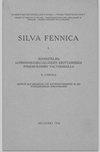Combined effects of provenance and slow-release fertilizer on nursery and field performance of yellowhorn seedlings
IF 1.7
3区 农林科学
Q2 FORESTRY
引用次数: 8
Abstract
Yellowhorn (Xanthoceras sorbifolium Bunge) has been widely planted for biodiesel production in China, but has frequently shown poor field performance. Container-grown yellowhorn seedlings originating from three Chinese provenances, Wengniute Qi (WQ), Alukeerqin Qi (AQ), and Shanxian (SX), were fertilized with slow-release fertilizer (SRF) at 40, 80, 120, 160 or 200 mg N seedling–1. Tree growth, survival and nutrient content were measured after one year’s growth in a greenhouse followed by two years in a field site. Plants from AQ and SX tended to have higher stem and root P contents in the nursery. Higher rates of SRF increased root N, and stem and root P contents. After one year in the nursery, there were a number of interactions between provenance and SRF for plant growth responses and nutrient content in the nursery, however after two years of additional growth in the field, plants from the different provenances generally responded similarly to applied SRF in the nursery, with few interactions. Final plant height was approximately 10% lower in trees from provenance SX but was not affected by application of SRF. Conversely, final trunk diameter and stem and root biomass were unaffected by provenance but increased with higher rates of applied SRF. Our results indicate that application of SRF may be a useful tool to nutrient load yellowhorn in the nursery and facilitate transplanting performance in the field. Overall, optimal nursery and field performance of yellowhorn were observed in provenance AQ at 120–200 mg N seedling–1 SRF. We suggest that growers consider a wider range of yellowhorn provenances and SRF rates (above 200 mg N seedling–1) to yield even better growth response.种源与缓释肥料对黄角苗圃和田间生产性能的联合影响
黄角(Xanthoceras sorbifolium Bunge)在中国被广泛种植用于生产生物柴油,但经常表现出较差的田间性能。以3个中国种源——翁牛特齐、阿鲁科尔沁齐和山县的集装箱黄角苗木为研究对象,在苗期1号分别施用40、80、120、160和200 mg N缓释肥。树木生长、存活和养分含量在温室中生长一年,然后在田间生长两年。AQ和SX植株苗圃中茎、根磷含量较高。较高的SRF速率提高了根氮含量,提高了茎和根磷含量。苗圃一年后,种源与SRF在苗圃内的植物生长响应和营养含量之间存在许多相互作用,但在田间额外生长两年后,不同种源的植物对苗圃内施用SRF的反应一般相似,相互作用很少。种源SX的最终株高约低10%,但不受SRF施用的影响。相反,最终树干直径和茎、根生物量不受种源的影响,但随施SRF量的增加而增加。结果表明,施SRF可有效提高黄角苗圃养分负荷和田间移栽性能。总体而言,种源AQ在120 ~ 200 mg N - 1 SRF下黄角的苗圃和田间表现最佳。我们建议种植者考虑更广泛的黄角品种和SRF率(超过200 mg N幼苗- 1),以获得更好的生长反应。
本文章由计算机程序翻译,如有差异,请以英文原文为准。
求助全文
约1分钟内获得全文
求助全文
来源期刊

Silva Fennica
农林科学-林学
CiteScore
3.50
自引率
11.10%
发文量
21
审稿时长
3 months
期刊介绍:
Silva Fennica publishes significant new knowledge on forest sciences. The scope covers research on forestry and forest ecosystems. Silva Fennica aims to increase understanding on forest ecosystems, and sustainable use and conservation of forest resources. Use of forest resources includes all aspects of forestry containing biomass-based and non-timber products, economic and social factors etc.
 求助内容:
求助内容: 应助结果提醒方式:
应助结果提醒方式:


